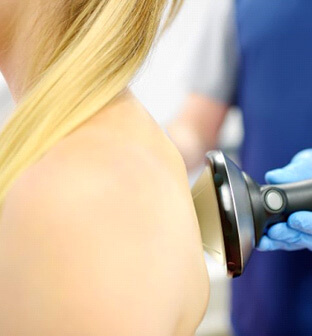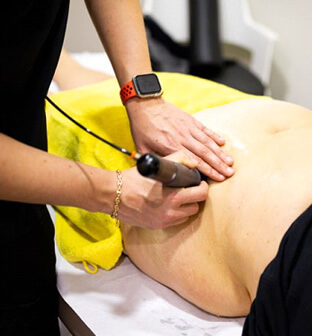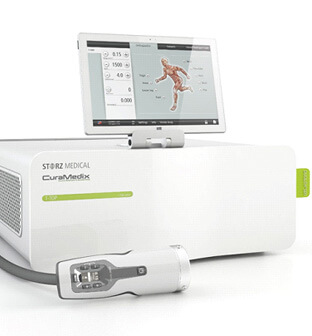
Shockwave Therapy – Asheville, NC
Non-Invasive Treatment for Stubborn Injuries
Ongoing pain from a muscle, tendon, or ligament injury can put a damper on your quality of life and limit your ability to carry out important tasks. Some patients must resort to surgery to find relief, but did you know that for many people, non-invasive options can prevent the need to “go under the knife”? Shockwave therapy is a non-invasive treatment for stubborn injuries that can help Asheville patients to feel better and enjoy life to the fullest.
Why Choose Asheville Non-Surgical Orthopedics for Shockwave Therapy?
- Highly Accomplished Doctor of Osteopathy
- Kind & Caring Medical Team
- Effective, Non-Invasive Therapy
What Is Shockwave Therapy?
Shockwave therapy goes by a few different names. It may also be referred to as Extracorporeal Shockwave Therapy (ESWT) or Extracorporeal Pulse Activation Technology (EPAT®). All such terms refer to the use of low-frequency acoustic waves to instigate a healing response within the body.
Essentially, the therapy increases blood flow to the targeted area. The blood brings with it all the nutrients and other components that are necessary for effective healing of injured muscles, tendons, and ligaments.
The use of shockwaves in medicine began in the 1960s, and since then, they have become a go-to treatment for many patients who are struggling with issues like frozen shoulder, plantar fasciitis, sports injuries, and more.
How Does Shockwave Therapy Work?

During an ESWT session, our team will apply a gel to your skin at the targeted area. Then, we will use a wand-like device (similar to an ultrasound wand) to begin delivering shockwaves. We will gradually increase the strength of the shockwaves until a therapeutic level is reached, or to a level that you can tolerate without too much difficulty.
Shockwave therapy can be mildly uncomfortable. It may feel like a continual tapping or knocking sensation. However, it should not cause extreme pain. In fact, many patients notice a reduction in pain soon after their first session, though it may take several sessions in order to experience optimum results. Each treatment is likely to take less than 15 minutes.
Radial Vs. Focused Shockwave Therapy
'

In discussions about shockwave therapy, you might hear a number of different terms, including radial shockwave therapy, focused shockwave therapy, EPAT, ESWT, and more. It can all be a little confusing! Our team will be happy to answer your questions during your consultation. We will recommend the type of shockwave therapy that we believe will be most beneficial for your unique situation. In the meantime, you can gain a basic understanding of the differences between radial and focused shockwave therapy by reading the information below.
What Is Radial Shockwave Therapy?

Both radial and focused shockwave therapy use energy pulses in a therapeutic capacity. In radial shockwave therapy, which is also known as Extracorporeal Pulse Activation Technology (EPAT), the shockwave is strongest at the site of the shockwave device and becomes weaker the farther it travels.
Because the energy pulse weakens the farther it travels into the body, radial shockwave therapy is often best for conditions that affect the skin as well as tissues just beneath the skin (anything within 3 – 4 cm of where the shockwave device contacts the body). Musculoskeletal issues that are deeper in the body are unlikely to benefit as much from this type of treatment.
Radial shockwave therapy is the most common type of shockwave treatment. However, in some ways, it is not as powerful or effective as focused shockwave therapy.
What Is Focused Shockwave Therapy?

Focused shockwave therapy is also known as Extracorporeal Shockwave Therapy (ESWT). (Sometimes, EPAT is referred to as ESWT. If you are ever confused about the type of treatment you are receiving, simply ask for details.)
This type of treatment uses a device that utilizes a combination of crystals and electrical currents to focus the energy of the shockwave. Therefore, it can maintain its strength within a concentrated zone even as it moves into the body’s deeper tissues. In fact, depending on the attachment used, the shockwaves may reach up to 12 cm beneath the point of contact.
The technology used in focused shockwave therapy often makes it more effective than radial shockwave therapy. It is also better for use in larger areas of the body where deeper penetration is necessary, such as the hips and lower limbs. It is often best for conditions that affect the nerves, joints, and bone marrow. For example, it can be used to address bone marrow lesions.
Combining Shockwave Therapies

In some cases, choosing the right shockwave therapy is not a matter of “this or that.” In fact, you might benefit from both. Radial shockwaves can treat injuries closer to the skin, helping to reduce pain and encourage healing. Focused shockwaves can do the same thing deeper within the body, possibly treating the main source of tissue damage that is closer to the surface. During your consultation, we can discuss whether a combination of shockwave therapies might benefit you.
Choosing the Right Shockwave Therapy for You

Radial shockwave therapy is available at many locations, including those that do not have the oversight of a physician. However, focused shockwave therapy is less common because it is somewhat newer, requires a higher level of training, and is only available at clinics where a qualified musculoskeletal physician is present.
We advise you to visit a practice that has the technology necessary to offer both types of treatment. That way, you can make sure that you will receive customized shockwave therapy that is tailored to the details of your specific situation. Visiting a provider that only offers radial therapy could produce less than optimal results!
At Asheville Non-Surgical Orthopedics, Dr. Pinkston can assess your individual needs and provide truly top-quality care. Whether that involves focused, radial, or combined shockwave therapy, you can be confident that our team’s goal is to help you enjoy improved mobility, reduced pain, and a heightened overall quality of life!
Benefits of Shockwave Therapy

Shockwave therapy is truly a standout treatment when it comes to relieving pain without the use of medications or invasive surgery. It works with your body’s natural processes to heal damaged tissues and help you feel better! What are some of the specific benefits that it offers? Below, we discuss some of its most remarkable advantages.
It Is Effective

ESWT is FDA-approved and as a track record of success for helping many different kinds of patients with a range of conditions. For example, it has helped countless individuals with issues like plantar fasciitis, tennis elbow, golfer’s elbow, and more. In fact, it is sometimes more effective than traditional treatments, such as NSAIDs and physical therapy, for such complaints.
Of course, not everyone enjoys exactly the same results with shockwave therapy. Some people experience fast and lasting pain relief. For others, results appear after a few sessions. Since shockwave therapy is so low-risk, though, it is certainly worth investing for anyone who is looking for a non-surgical, non-pharmaceutical means of pain relief.
It Does More Than Treat Symptoms

Some pain relief therapies are a band-aid measure; they can reduce discomfort, but they do little to actually heal the underlying problem. Shockwave therapy is different. It stimulates blood flow to the affected area and supports your body’s ability to heal itself. Depending on the nature and extent of your problem, that means you might be able to experience permanent relief from your symptoms!
The Treatment Process Is Fast and Easy

Whenever possible, Dr. Pinkston and our team focus on providing therapies that will have minimal impact on our patients’ daily routines. Shockwave therapy certainly fits that description!
Treatment sessions tend to be quite short, often lasting just 15 – 20 minutes. No downtime is required afterward, so you can get right back to your normal routine. Plus, side effects are often minimal. Minor bruising and swelling may occur, but severe side effects are practically unheard of.
It Is Cost-Effective

Shockwave therapy is non-invasive and does not take a lot of time, so it tends to be affordable for most patients. It might even help you save money in the long run because, as your symptoms subside, you may spend less money on temporary pain relief measures, such as medications.
For some individuals, shockwave therapy might even prevent the need for expensive surgical treatment. Not only can surgery be pricey, but you would also have to factor in the cost of taking time off work to recover.
It Can Complement Other Treatments

By itself, shockwave therapy can provide some pretty great results. However, it can also be combined with other treatments in order to optimize patient outcomes. For example, it may be used alongside physical therapy or regenerative medicine injections. Dr. Pinkston can evaluate the details of your case and propose a treatment plan that aims to help you heal as efficiently and fully as possible.
Understanding the Cost of Shockwave Therapy

The total cost of shockwave therapy can vary from patient to patient. When you visit us for a consultation, we can share some specific numbers with you. Because this therapy does not require a lot of time, and it is noninvasive, it often costs less than more complex treatments. It is a smart investment in your health that could help you to get back to pain-free bodily function!
Factors That Can Affect the Cost of Shockwave Therapy

There are a few factors that may affect the cost of shockwave therapy:
- The type of shockwave therapy. Here at Asheville Non-Surgical Orthopedics, Dr. Pinkston and our team offer focused shockwave therapy. It is designed to address certain musculoskeletal conditions. Other medical practices may offer other types of shockwave therapy, which have different price points.
- The number of sessions necessary. Most patients require multiple shockwave therapy sessions to enjoy optimum results. Each session comes with its own fee.
- The location of a medical practice. It is common for medical practices to set their prices based on the cost of living in the local area and other geographical factors.
A Look at the Prices of Different Types of Shockwave Therapy

There are two different types of shockwave therapy:
- Radial shockwave therapy (also known as Extracorporeal Pulse Activate Technology or EPAT). This type of treatment aims to facilitate healing by encouraging increased blood flow to the site of damaged tissues.
- Focused shockwave therapy (also known as Extracorporeal Shockwave Therapy or ESWT). This is a bit more targeted and powerful than radial shockwave therapy. In our practice, Dr. Pinkston often uses focused shockwave devices from CuraMedix to produce optimum results. They are among the best devices on the market.
Because both of the abovementioned options are often casually referred to as “shockwave therapy,” it is important that you exercise caution when scheduling an appointment. Do not be lured in by price alone. Make sure a practice offers the type of therapy you need and that they are well-qualified to do so.
How to Make Shockwave Therapy Affordable

Sadly, most health insurance policies do not offer coverage for shockwave therapy. If that changes in the future, our team can provide you with a statement that will help you take advantage of your benefits.
The good news is that there are other provisions that might make it easier to afford your treatment. For example, we are partnered with Varidi, a third-party financing company. Most patients are eligible for a low-interest payment plan that fits their monthly budget. The application process is fast and easy! We also accept funds from healthcare savings accounts and flexible spending accounts. If you choose to pay with Bitcoin, you can even receive a special discount.
Shockwave therapy is a reasonably priced treatment that could improve your overall wellness! Get in touch with our team today to learn more about it.
Shockwave Therapy FAQs

If you’re struggling with chronic and/or acute discomfort in your muscles and joints, then you’ll likely benefit greatly from Extracorporeal Shockwave Therapy (ESWT), otherwise known as shockwave therapy. While this treatment is highly advanced and effective, it’s natural to want to know more about the procedure before committing to anything. That’s why our team has taken the time to collect and answer some of the most frequently asked questions we get about shockwave therapy in Asheville! Read on to learn more or give us a call today if you don’t see the information you’re looking for.
What Can I Expect from Shockwave Therapy?
Thanks to our advanced and reliable equipment, many patients claim to immediately experience pain relief after finishing their treatment. However, it can sometimes take about four weeks for some people to begin to feel the results of their procedure. Due to the pressure waves that promote improved blood circulation and stimulate metabolism, the process generally alleviates discomfort and renews your mobility, enhancing your overall well-being. Over 80% of shockwave therapy patients claim to feel pain-free and/or experience drastically reduced pain.
What Disorders Can Be Treated with Shockwave Therapy?
Shockwave therapy is typically used to help people who are struggling with impaired mobility, which also reduces their overall quality of life. The most common areas where acute and/or chronic musculoskeletal discomforts occur and can be addressed by this treatment include:
- Lower extremity
- Upper extremity
- Shoulders
- Neck
- Back and chest
- Foot and ankles
- Myofascial trigger points
What Are the Possible Side Effects of Shockwave Therapy?
Since shockwave therapy is a non-invasive ESWT treatment, you won’t have to undergo any surgery to treat your musculoskeletal symptoms. For this reason, you shouldn’t typically expect any risks or experience side effects after your procedure. In some cases, patients have reported feeling minor discomfort after the treatment, which might continue for several days. Even so, any residual pain or soreness from the procedure will be equivalent to what you’d typically experience after intense exercise or a full day of hard work.
Why Consider Non-Invasive Shockwave Therapy?
The ESWT treatment has a tried and tested success rate that is equal to or beyond that of more traditional methods, including surgery! On top of that, the process doesn’t involve the risks, complications, or lengthy recovery time that usually comes with a more extensive procedure. Other advantages of ESWT over surgical treatments include:
- No local anesthetics required
- Performed in a short amount of time
- Completed right in your physician’s clinic/office
- Can move around immediately after the process
- Return to normal daily activities after 24/48 hours
- Can start exercising intensely after 4 weeks